22 Eye-Opening Creator Economy Statistics (2024 Data)

How many professional creators are there? How many creators are there total?
How much do creators earn per sponsored post, and what other income streams do they use?
In this post, we’ve rounded up the best creator economy statistics from reports published around the web.
They cover all of these questions and more and really open your eyes to common misconceptions we all have about content creation.
Editor’s top picks – creator economy statistics
- The creator economy pool has a total of 207 million creators globally. (Linktree)
- In 2023 the global influencer marketing industry is expected to grow to $21.1B. (Influencer Marketing Hub)
- Only 12% of full-time creators make more than $50,000 in annual income. (Linktree)
- Lifestyle influencers ask for $994 per brand collaboration on average. (Collabstr)
- Patreon is used by over 250,000 creators to generate revenue. (Patreon)
General creator economy statistics
1. There are 207 million creators on the web
The global creator economy includes a creator pool of over 207 million creators from around the world.
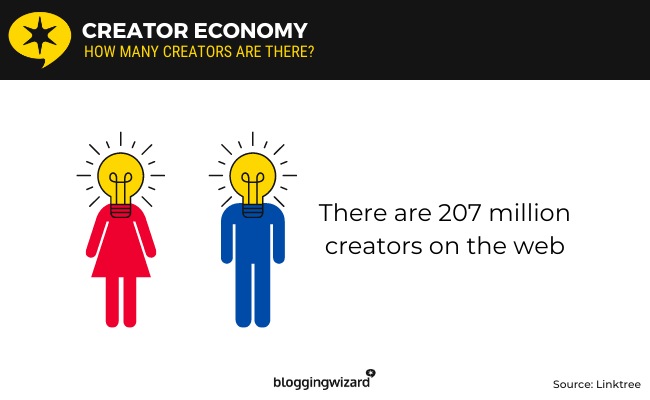
This data comes from Linktree’s 2022 Creator Report.
They also revealed a collective social media user base of 4.2 billion social media users, which gives you an idea of the potential professional creators have in growing a following.
Source: Linktree
2. Facebook has the largest user base with 2.9 billion monthly active users
Statista tracks user base data for all major social media platforms.
Their data reveals that Facebook has the largest user base with 2.9 billion monthly active users by the end of fourth quarter of 2022.
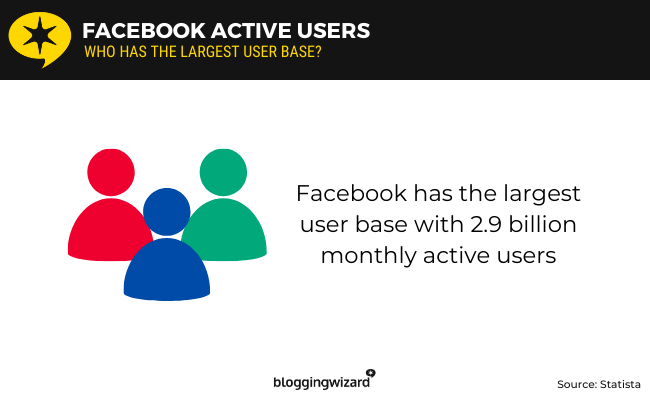
This is interesting as a majority of the statistics in this article point to Instagram, TikTok and YouTube as being the most influential social media platforms for creators.
Source: Statista
3. 67% of all influencers are nano influencers with 1,000 to 10,000 followers
According to data uncovered by Linktree, most creators, or 67.15%, are nano influencers, meaning they have between 1,000 and 10,000 followers.
This percentage makes up the majority of influencers, or roughly 139 million of all content creators.

The next biggest chunk of creators are micro influencers, or influencers with 10,000 to 100,000 followers.
There are 41 million micro influencers, which is 19.81% of all creators.
There are 2 million macro influencers (100,000 to 1 million followers) and 2 million mega influencers (over 1 million followers).
These numbers make up less than 1% of all creators globally each, or 1.94% combined.
23 million creators have fewer than 1,000 followers. This number makes up 11.11% of all creators.
Source: Linktree
4. 66% of creators work part time as content creators
This data comes from a survey of 9,500 creators, which was conducted by Linktree for their 2022 Creator Report.
66% of respondents reported working as creators part time, which means 34% of creators are full-time creators.

36% are amateur creators who have only been making content for less than one or equal to one year.
43% of creators spend less than or equal to five hours a week on content creation.
Source: Linktree
5. 77% of social media influencers are women
For Collabstr’s 2023 Influencer Marketing Report, the brand surveyed 50,000 influencers.
They discovered a whopping 77% of respondents to be women while 23% were men.

This gender gap even became a trend on a per-platform basis.
According to survey results, 76% of influencers on TikTok are women while only 24% are men.
On Instagram, 79% of influencers are women while 21% are men.
The gap is smallest on YouTube. Here, 69% of influencers are women while 31% are men.
The trend continues when you compare follower counts of men and women on TikTok and Instagram.
However, the gap is smallest when you compare follower counts on YouTube, specifically among YouTubers with 50,000 to 500,000 subscribers.
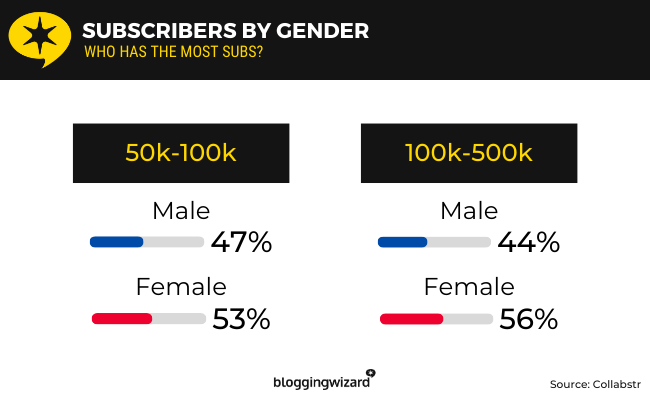
53% of YouTubers with 50,000 to 100,000 subscribers are women while 47% are men.
56% of YouTubers with 100,000 to 500,000 subscribers are women while 44% are men.
Source: Collabstr
6. 25% of influencers operate in the fashion and beauty niche
This stat comes from Influencer Marketing Hub in their 2023 State of Marketing Report.
They found that the fashion and beauty niche was popular among 25% of respondents, gaming among 12.9%, travel and lifestyle among 12.5%, sports among 12%, family, parent and home among 10.7%, and health and fitness among 6.8%.
19% of respondents voted for “other.”
However, it should be noted that Influencer Marketing Hub’s numbers come from a survey of 3,500 marketing agencies and brands.
Collabstr also publishes a report on influencer marketing every year.
While they don’t say what percentage of respondents voted for what, their report does state that the most popular niches (voted for by 50,000 influencers) are lifestyle, fashion, beauty, travel, modeling, and health and fitness.
Source: Influencer Marketing Hub
7. The global influencer marketing industry is expected to grow to $21.1B in 2023
The influencer marketing industry grew to $16.4 billion USD in 2022 and is expected to grow to $21.1B in 2023.
This data was uncovered by Influencer Marketing Hub, who also discovered, through a survey of 3,500 marketing professionals, that 67% of marketers plan to spend more on influencer marketing in 2023.
This means there’s a lot of potential for the average nano influencer to launch a full-fledged creator business.
There’s also a lot of potential for brands to circumvent ad-blocking technology by spending less on ad revenue and more on influencer marketing, including commissioning creators to create sponsored posts.
When brands do this with creators who have active, highly-engaged followings, their engagements from marketing campaigns have the potential to be higher than marketing campaigns that involve inserting ads in multiple channels.
Source: Influencer Marketing Hub
8. The United States is the #1 country for influencer marketing
Collabstr surveyed 50,000 influencers and 20,000 brands and marketing agencies.
The resulting data revealed the 10 most popular countries for brand deals.
The United States was ranked as the most popular country for paid collaborations between brands and influencers, followed by Canada, the UK, Australia and Germany.

This was followed by Mexico, France, Spain, the Netherlands and Italy.
When Collabstr broke this data down even more, they found that the top cities (all of which are in the United States and Canada) with the highest number of influencers included Los Angeles, New York City, Toronto, Vancouver and Atlanta.
Source: Collabstr
9. 67% of social media creators have never collaborated with a brand
In Linktree’s 2022 Creator Report, the company surveyed 9,500 creators.
They discovered that 67% have never collaborated with a brand on their social channels.
This is probably a major reason why the majority of creators are not making living wages.
Source: Linktree
10. The majority of influencers own accounts on 1.9 social media platforms
According to Collabstr’s report, on average, most social media influencers are monetizing accounts on around 2 platforms at a time.
This gives marketers wider target audiences to market their products to, perhaps even wider than they thought.
Source: Collabstr
11. 58% of creators produce multiple forms of content
In Linktree’s 2022 Creator Report, the company asked 9,500 creators about the content types they use.
While the majority of creators report only using one content type, 58% voted for two to four content types.
Content types include short-form videos, long-form videos, podcasts, blog posts, etc.
Source: Linktree
12. 62% of niche creators agree specializing improves engagement and reach
Linktree’s survey of 9,500 creators included niche creators.
A niche creator is a content creator whose content targets a specific niche, such as lifestyle, beauty, tech, etc.
62% of these creators believe picking a niche and dedicating your content to it increases your chances of growing an audience and receiving more likes, comments and conversions from your content.
Source: Linktree
Creator economy stats based on revenue
13. Only 12% of full-time creators make more than $50,000 a year
Linktree’s survey of 9,500 creators revealed that only 12% of full-time creators make more than $50,000 in annual income.
48% make less than $1,000.
This means the vast majority of full-time creators are not taking advantage of the large number of influencer marketing opportunities available today, either because they simply aren’t interested in accepting brand sponsorships or they don’t know how to get started.
3% of part-time creators make more than $50,000/year from content creation while 68% make less than $1,000.
Source: Linktree
14. Lifestyle influencers charge $994 for brand collaborations on average
Collabstr surveyed 50,000 influencers for their 2023 Influencer Marketing Report.
They found the lifestyle niche to be the highest-paid influencer niche on average, after excluding celebrity and entrepreneurial influencers.
Lifestyle influencers ask for $994 per brand collaboration on average.
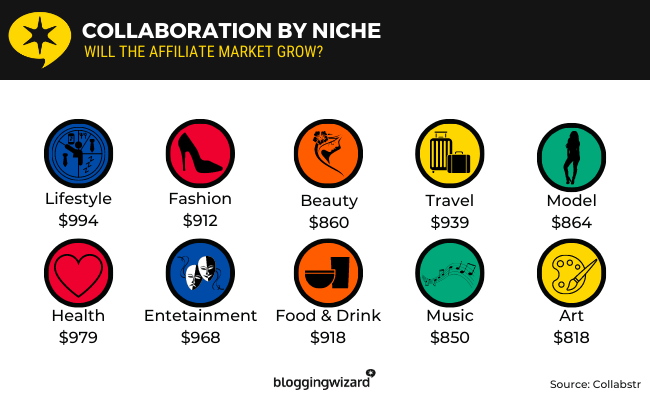
Health and fitness came in second at $979 per collaboration with comedy and entertainment coming in a close third at $968 per brand collaboration on average.
Travel ($939), food and drink ($918), fashion ($912), model ($864) and beauty ($860) followed.
Source: Collabstr
15. 41% of creators say selling their own physical products is the best way to monetize
When Linktree surveyed 9,500 creators in their 2022 Creator Report, they asked creators to vote for the income streams that drive revenue to their creator businesses.
23% of niche creators and 18% of non-niche creators voted for “own physical products” for a total of 41% of all creators.
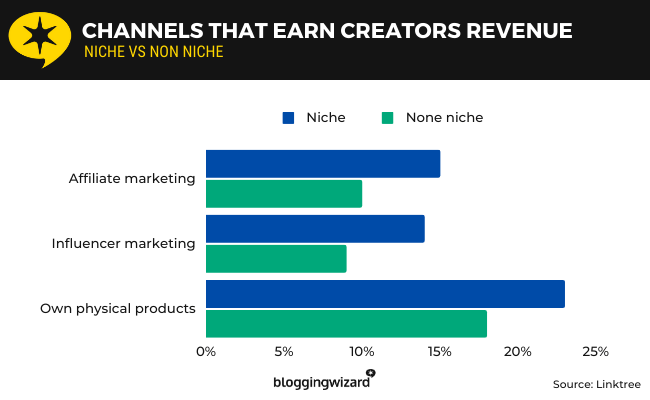
The next biggest income stream for creators is affiliate marketing, which was voted for by 25% of creators.
15% of niche creators and 10% of non-niche creators say affiliate marketing is an important revenue stream.
Influencer marketing was voted by 23% of creators as being the third best revenue stream.
This was voted for by 14% of niche creators and 9% of non-niche creators.
Source: Linktree
16. 25% of creators earn the most amount of revenue from their blogs or websites
Linktree’s survey of 9,500 creators revealed that although only 2% of creators say their largest audience is on their blog or website, 25% say they earn the most amount of revenue from a blog or website.
This is likely due to the simple fact of there being far less distractions on blogs and websites. Therefore, conversion rates are higher.
Source: Linktree
17. Over 250,000 creators earn revenue from Patreon
Patreon is a membership platform in which followers, or “patrons,” can support creators by subscribing to individual creators on a monthly basis (or on a per-content basis) in exchange for perks, such as early access, sub-only posts, sub-only livestreams, etc.
According to Patreon’s About page, there are over 250,000 creators on the platform who’ve generated over $3.5 billion in revenue from subscriptions.
There are also over 8 million active patron accounts, making Patreon a popular platform for independent creators.
Source: Patreon
Creator economy statistics for specific creator platforms
18. 12% of amateur creators say their biggest platform is TikTok
This stat comes from Linktree’s 2022 Creator Report.
12% of “beginner” creators consider TikTok to be their biggest platform while only 6% of “experienced” creators say the same thing.
Source: Linktree
19. 22% of professional creators say Facebook is their biggest platform
In Linktree’s 2022 Creator Report, 22% of professional creators say their biggest platform is Facebook versus 16% of amateur creators.
This is surprising given Facebook’s loss of influence over the last few years when compared to platforms like Instagram, TikTok and YouTube.
Source: Linktree
20. 45% of brand deals are made with TikTok influencers
In Collabstr’s 2023 influencer marketing report, the company analyzed 7,000 brand deals between marketers and influencers.
They found that 45% of deals were made with TikTok influencers while 39% were made with Instagram influencers.
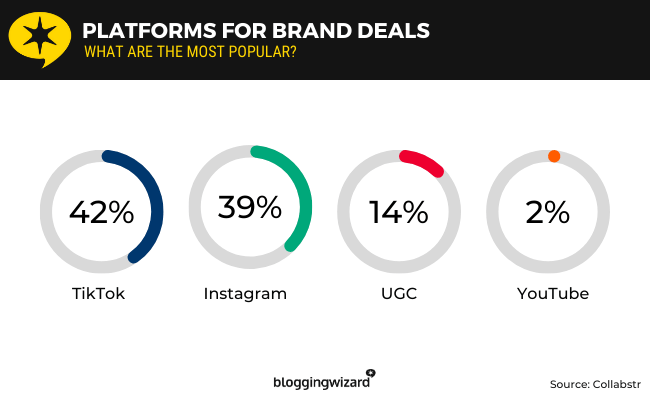
The numbers prove that TikTok has taken over Instagram in influence.
In 2022’s report, Collabstr found that 48% of paid collaborations were made on Instagram while 46% were made on TikTok.
Although the numbers are lower in 2023’s report, they demonstrate just how much TikTok has grown over the last few years and how it’s on course to leave other social media platforms behind.
Other than these two powerhouses, 14% of brands used user-generated content while 2% made collaborations with YouTubers.
Collabstr describes user-generated content as being “not specific to any particular platform.”
Source: Collabstr
21. 82% of influencers offer influencer marketing services on Instagram
When Collabstr surveyed 50,000 influencers, they found that 82% report using Instagram to offer paid collaborations to brands while 61% use TikTok.
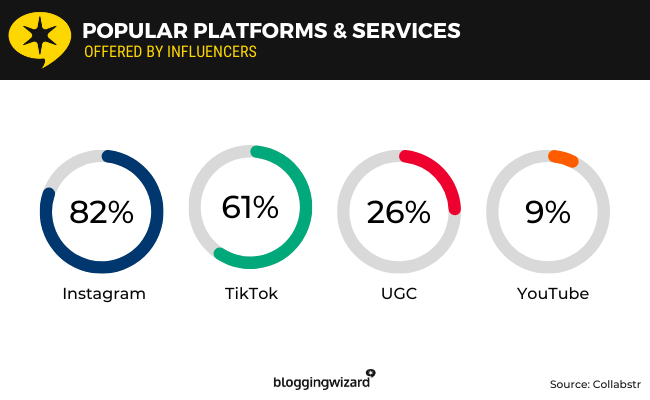
26% of influencers offer their services through user-generated content that’s not linked to a specific platform.
The remaining 9% of influencers offer their services on YouTube.
Source: Collabstr
22. The average cost per collaboration on YouTube is $418
While Collabstr’s report revealed Instagram and TikTok to be the most popular social platforms for influencer marketing, their report also revealed that YouTube collaborations net YouTube creators $418 per collaboration on average.
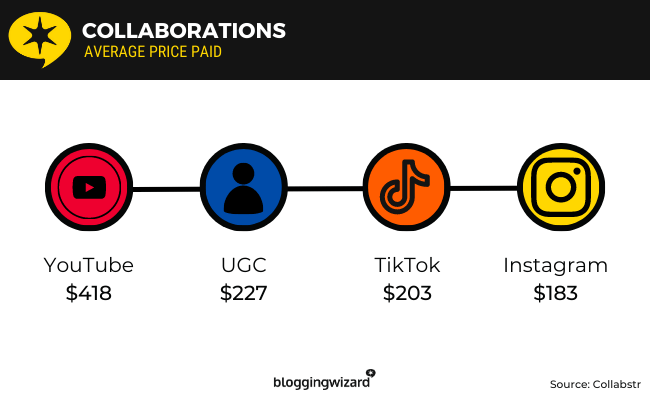
This data comes from a survey of 50,000 influencers.
This is twice the average amount TikTok and Instagram influencers make on average, which is $203 and $183 per collaboration on average.
Collabstr’s theory is that because there are more creators on Instagram than any other platform and because Instagram and TikTok content is more efficient to create than YouTube content, it’s only inevitable for these rates to be as low as they are in comparison to YouTube’s.
Furthermore, Collabstr’s survey, which includes data from 50,000 influencers and 20,000 brands and marketing agencies, revealed that on average, influencers only receive about 50% of their asking prices for collaborations.
Here are the actual prices influencers make per collaboration on different platforms versus what they ask for:
Actual Prices of Asking Prices
- YouTube – Creators with a YouTube channel received $418 of their original asking price of $791 on average.
- TikTok – $203 of original asking price of $460.
- Instagram – $183 of original asking price of $363.
Source: Collabstr
Creator economy statistics sources
Final thoughts
Social media platforms, blogs and websites have made it possible for just about anyone to publish content to the world and even monetize it.
However, the statistics in this post prove that although the web has hundreds of millions of creators out there, only a small fraction of them have learned how to properly monetize the platforms they’ve built for themselves.
According to the statistics in this post, creating your own products, specifically physical products, appears to be the best way to monetize a creator business.
You can do this easily by dropshipping merch, but there are plenty of other income streams to pick from as well.
Affiliate marketing and influencer marketing are the next most popular revenue streams for creators.
These involve using your influence to market other people’s products to your growing audience.
While it’s not as stable as offering your own products, it provides a much easier path to monetization.
Affiliate marketing is an easy enough strategy to comprehend: join an affiliate program, recommend a product attached to that program and provide an affiliate link for it, then collect the profits as you convert more and more customers.
Getting sponsored is another story.
Consider making a media kit out of a PDF document, and include the following data:
- Social media accounts you’re active on.
- Data for social media accounts, including total followings, likes per post, comments per post, views per video, etc.
- Data on your audience, including demographics and the niche your content falls under.
- Details on the types of posts you can create for sponsors.
Adding this little touch to your pitch can really do a lot to increase your odds of landing your first sponsor.
As for brands, be sure to ask for all of this information if creators you’re thinking of sponsoring don’t offer it upfront.
The most important thing is making sure the creators you sponsor have audiences that match your customer base.
Further reading:
